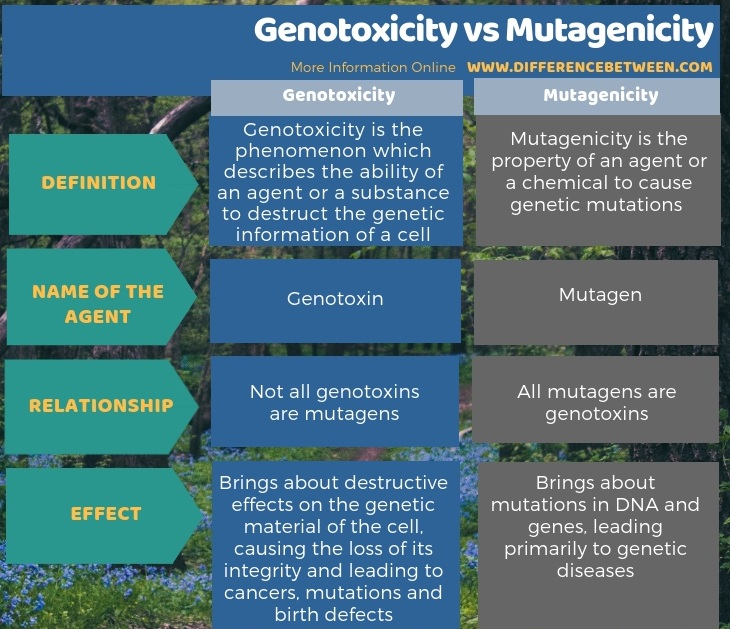The key difference between genotoxicity and mutagenicity is that genotoxicity is the ability of a substance to cause toxicity on DNA/genetic material of a cell while mutagenicity is the ability of an agent to cause mutations.
Genotoxicity and mutagenicity are two similar terms, often misinterpreted and interchangeably used by people. Genotoxicity is the toxic effect created by a chemical or an agent on genes or DNA of a cell. Thus, a chemical that has a genotoxic effect is a genotoxin. In contrast, mutagenicity is the ability of a substance to cause or induce mutations. A genotoxic chemical is not necessarily a mutagenic substance. They may be mutagens. However, all mutagenic agents are genotoxic since they have the property of destructing genetic material of the cell.
CONTENTS
1. Overview and Key Difference
2. What is Genotoxicity
3. What is Mutagenicity
4. Similarities Between Genotoxicity and Mutagenicity
5. Side by Side Comparison – Genotoxicity vs Mutagenicity in Tabular Form
6. Summary
What is Genotoxicity?
Genotoxicity is the ability of a substance to create toxicity on the genetic material of the cell, leading primarily the onset of cancer. Genotoxic substances can be physical and chemical substances that can alter the gene sequences, leading the changes in genetic information. If a genotoxin affects the genetic material of a somatic cell, it will not be hereditary. In contrast, if the genotoxic effect acts on germ cells, it can be hereditary. The genotoxic effect can be minimized by DNA repair mechanisms, mainly enzyme activity of the cell. Also, upon genotoxicity, cells may undergo apoptosis.

Figure 01: Genotoxic Damage
DNA damages caused by genotoxins can be analyzed by using different DNA assays. Common DNA damages include deletions, insertions, double-stranded breaks, chromosomal aberrations, and cross-linking. Deletions and insertions refer to the removal and addition of base pairs, respectively. Moreover, double-stranded breaks form nicks in the double-stranded DNA, thereby forming fragments of DNA. Chromosomal aberrations, on the other hand, are large scale effects that can develop into changes in the ploidy levels. Radiation and chemical agents such as alkylating agents, nitric oxides, base analogues, intercalating agents are common genotoxins.
What is Mutagenicity?
Mutagenicity is the ability of an agent to induce mutations. A mutation is a permanent transmissible change in DNA that leads to different abnormal conditions if not repaired. The agents or chemicals that cause mutations are mutagens. As mentioned above, mutagens are genotoxins. Moreover, mutagens can be physical, biological or chemical agents. Physical mutagens mainly include different radiation types. It can be ionizing or non-ionizing radiations. These radiations disrupt the double helix structure of DNA, causing mutations. Furthermore, biological mutagens include various viruses that infect cells and attack DNA. Therefore, these viruses are capable of incorporating their DNA into the host, causing mutations. Chemical mutagens, on the other hand, include base analogues, nitric oxide species, intercalating agents that can cause transitions and transversions of the DNA sequence. They lead to the formation of apurinic and apyrimidinic sites, creating mutations in DNA.

Figure 02: Effect of a Mutagen
The ability for mutagenicity decreases with the increased efficiency of the DNA repair enzymes and repair mechanisms operating in the cell. Otherwise, mutations will end up causing cancers, genetic disorders and various complications.
What are the Similarities Between Genotoxicity and Mutagenicity?
- Genotoxicity and mutagenicity are two phenomena that affect genes or DNA of an organism.
- Both are able to alter the genetic material of a cell.
- Moreover, there are chemical and physical modes of each effect.
- Genotoxin may be a mutagen or not, but all mutagens are genotoxins.
- Both mutagenicity and genotoxicity can be reduced by the action of DNA repair enzymes and mechanisms operating in the cell.
- Both may lead to the onset of cancer and other DNA based genetic diseases.
What is the Difference Between Genotoxicity and Mutagenicity?
Genotoxicity and mutagenicity are two terms sometimes used interchangeably. However, genotoxicity refers to the ability of an agent or a chemical to pose a toxic effect on the genetic material of a cell while mutagenicity is the property of an agent or a substance to create or induce mutations in DNA. So, this is the key difference between genotoxicity and mutagenicity.
Moreover, it is important to remember that while all mutagens are genotoxic, not all genotoxic substances are mutagenic since genotoxins may be mutagens, carcinogens or teratogens.
Below infographic summarizes the difference between genotoxicity and mutagenicity.

Summary – Genotoxicity vs Mutagenicity
Both genotoxicity and mutagenicity often refer to the ability of an agent to change the DNA of a cell, leading to different chromosomal aberrations and mutations. However, in a deep sense, genotoxicity refers to the ability of an agent to alter the structure, information content, or segregation of DNA while mutagenicity refers to the property of an agent to induce genetic mutation. So, this is the key difference between genotoxicity and mutagenicity. Besides, genotoxicity is not necessarily associated with mutagenicity. Genotoxins may be carcinogens or teratogens instead of mutagens. But, all mutagens are genotoxins.
Reference:
1. Phillips, David H, and Volker M Arlt. “Genotoxicity: Damage to DNA and Its Consequences.” EXS, U.S. National Library of Medicine, 2009, Available here.
2. Hsu, Kuo-Hsiang, et al. “Mutagenicity in a Molecule: Identification of Core Structural Features of Mutagenicity Using a Scaffold Analysis.” PloS One, Public Library of Science, 10 Feb. 2016, Available here.
Image Courtesy:
1. “Genotoxic Damage” By Genotox – Own work (CC BY-SA 3.0) via Commons Wikimedia
2. “Benzopyrene DNA adduct 1JDG” By Zephyris (CC BY-SA 3.0) via Commons Wikimedia
ncG1vNJzZmivp6x7pbXFn5yrnZ6YsqOx07CcnqZemLyue8OinZ%2Bdopq7pLGMm5ytr5Wau26zxKemraeonrCqwNhmmKecXaLCta3GnqWim5mpxnA%3D